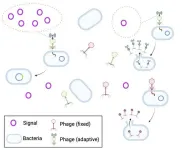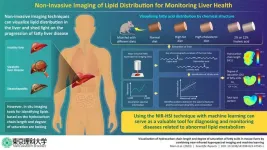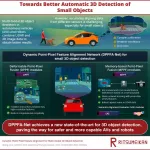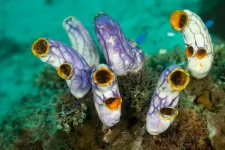(Press-News.org) Children and adults with rare, deadly genetic diseases have fresh hope for curative therapies, thanks to a new collaboration between the Innovative Genomics Institute (IGI) and Danaher Corporation, a global life sciences and diagnostics innovator.
The new Danaher-IGI Beacon for CRISPR Cures center will use genome editing to address potentially hundreds of diseases, including rare genetic disorders that have no cure. The goal is to ensure treatments can be developed and brought to patients more quickly and efficiently.
The IGI comprises genetics researchers and clinician experts from three University of California campuses: UCSF, UCLA and UC Berkeley, where the institute is housed, as well as other research institutions. Danaher will provide tools, reagents, resources and expertise to accelerate preclinical and clinical development and establish new standards for safety and efficacy.
The center will work first on CRISPR treatments for two genetic defects of the immune system: familial hemophagocytic lymphohistiocytosis (HLH), which causes immune cells to become overactive, damaging tissues and organs throughout the body; and Artemis-deficient severe combined immunodeficiency (ART-SCID), in which T and B lymphocytes fail to mature, making infants vulnerable to fatal infections.
The standard treatment for both conditions, a bone marrow transplant, is inadequate due to frequent complications.
“With CRISPR, we can speed up the development of improved therapies that can reach all the patients who need them,” said Jennifer Puck, MD, a pediatrics professor who directs the UCSF Jeffrey Modell Diagnostic Center for Primary Immunodeficiencies. “All patients deserve a sense of urgency – including those with rare diseases, many of whom are children.”
Since the CRISPR platform being created at IGI could, in theory, be reprogrammed to address any gene mutation, the goal is to use treatments for HLH and ART-SCID as models to develop a scalable approach from which new medicine for other genetic diseases can be rapidly developed.
“The unique nature of CRISPR makes it ideal for developing and deploying a platform capability for CRISPR cures on demand,” said Fyodor Urnov, IGI’s Director of Technology and Translation, who is overseeing the project along with Doudna and IGI Executive Director Brad Ringeisen. “Danaher and the IGI are in a unique position to potentially create a first-of-its-kind CRISPR cures ‘cookbook’ that could be used by any team wishing to take on other diseases.”
ART-SCID and HLH are typical of many rare diseases in that they have small patient populations, making drug development challenging and cost prohibitive. On average, it takes 10 years for a single clinical trial.
HLH and ART-SCID are two examples of a class known as inborn errors of immunity or IEIs. Each IEI is very rare, but collectively there are about 500 such diseases affecting more than 112,000 patients.
“We can develop CRISPR cures in a laboratory, but at the end of the day we need a way to turn those into clinical products for thousands of patients,” says IGI founder Jennifer Doudna, PhD, a UC Berkeley biochemist who won the Nobel Prize for co-developing CRISPR.
Currently there are only a few hundred patients in clinical trials for CRISPR-based therapies; the IGI hopes its work will allow that number to ramp up ten-fold over the next decade.
After decades of research, Puck and UCSF Pediatrics Professor Mort Cowan, MD, successfully treated 14 children with ART-SCID, known colloquially as Bubble Baby Disease, by inserting a corrected version of the Artemis gene into the children’s own bone marrow stem cells using a delivery system known as a lentivirus. A CRISPR-based version of this treatment could more precisely target where the gene copies go, avoiding possible toxicity from lentiviral interference with genes near sites of insertion in the genome.
Both ART-SCID and HLH have extensive patient registries to facilitate enrollment in future clinical trials. Since both are diseases of blood-forming bone marrow stem cells that renew the immune system throughout the life span, targeting these cells can bypass challenges in delivering CRISPR molecules to tissues in other disorders.
“We know how to deliver the CRISPR molecules into the cells to fix them,” Cowan said. “We also know how to reach patients, because there is an existing registry and network of expert physicians. By focusing on ART-SCID and HLH first, we aim to create a roadmap through pre-clinical and clinical development and lead the way for other indications, whether they are rare or not.”
The IGI team includes UCSF physician-scientists Matthew Kan, MD, PhD, Puck and Cowan focusing on ART-SCID; and David Nguyen, MD, PhD, Michelle Hermiston, MD, PhD and Bryan Shy, MD, PhD, focusing on HLH. Petros Giannikopoulos, MD, director of IGI’s Clinical Laboratory, will be the center’s diagnostic and analytical lead. Donald Kohn, MD, of UCLA will be involved in translating the gene editing approaches developed at UCSF and UC Berkeley to clinical cell manufacturing in the UCLA Human Gene and Cell Therapy Facility.
Cowan, Kan, Kohn and Puck are recipients of grants from the California Institute of Regenerative Medicine, CIRM, which have enabled them to reach the current stage of their work with the Beacon center.
About UCSF: The University of California, San Francisco (UCSF) is exclusively focused on the health sciences and is dedicated to promoting health worldwide through advanced biomedical research, graduate-level education in the life sciences and health professions, and excellence in patient care. UCSF Health, which serves as UCSF's primary academic medical center, includes top-ranked specialty hospitals and other clinical programs, and has affiliations throughout the Bay Area. UCSF School of Medicine also has a regional campus in Fresno. Learn more at https://ucsf.edu, or see our Fact Sheet.
About the Innovative Genomics Institute: The Innovative Genomics Institute (IGI) is a joint effort between the Bay Area’s leading scientific research institutions, UC Berkeley and UC San Francisco, with affiliates at UC Davis, UCLA, Lawrence Berkeley National Laboratory, Lawrence Livermore National Laboratory, Gladstone Institutes, and other institutions. Founded by Nobel laureate Jennifer Doudna, the IGI’s mission is to bridge revolutionary genome-editing tool development to affordable and accessible solutions in human health, climate, and agriculture. We are working toward a world where genomic technology is routinely applied to treat genetic disease, enable sustainable agriculture, and help achieve a carbon-neutral economy. www.innovativegenomics.org.
###
Follow UCSF
ucsf.edu | Facebook.com/ucsf | YouTube.com/ucsf
END
New CRISPR Center brings hope for rare and deadly genetic diseases
2024-01-09
ELSE PRESS RELEASES FROM THIS DATE:
Three researchers awarded $1 million each to study new heart disease treatments, causes
2024-01-09
DALLAS, Jan. 9, 2024 — A physician-scientist from Massachusetts researching whether chemicals naturally occurring in foods could help treat heart disease, a genetics expert from Pennsylvania exploring the molecular mechanisms of lipid metabolism and cardiovascular diseases and a California-based professor of cardiovascular medicine studying how vaping impacts the development of abdominal aortic aneurysms are the most recent American Heart Association Merit Award recipients. Over the next five years, each researcher will receive a total of $1 million in funding from the Association, the world’s leading voluntary organization focused on heart and brain health and research, ...
The value of information gathering for phages
2024-01-09
Phages, the viruses that infect bacteria, will pay a high growth-rate cost to access environmental information that can help them choose which lifecycle to pursue, according to a study. Yigal Meir and colleagues developed a model of a bacteria-phage system to investigate how much the viruses should be willing to invest to acquire information about their local environment. A temperate phage, once inside a bacterium, can choose one of two life cycles. In the lytic cycle, the phage turns the bacterium ...
Protecting newborns: Research lays the groundwork for a lifesaving vaccine
2024-01-09
BINGHAMTON, N.Y. -- Researchers from Binghamton University, State University of New York are unraveling the workings of Group B Strep (GBS) infections in pregnant women, which could someday lead to a vaccine.
One in five pregnant women carry Streptococcus agalactiae (Group B Strep or GBS) in the vaginal tract, which is typically harmless — except when it isn’t.
The bacterial infection poses serious and even fatal consequences for newborns, including pneumonia, sepsis and meningitis, which can have long-term effects on the child’s cognitive function.
Researchers ...
New study unveils machine learning-aided non-invasive imaging for rapid liver fat visualization
2024-01-09
Steatotic liver disease (SLD), previously known as non-alcoholic fatty liver disease, which includes a range of conditions caused by fat build-up in the liver due to abnormal lipid metabolism, affects about 25% of the population worldwide, making it the most common liver disorder. Often referred to as “silent liver disease,” SLD progresses without noticeable symptoms and can lead to more severe conditions like cirrhosis (liver scarring) and liver cancer.
A liver biopsy—an invasive procedure involving liver tissue sample extraction from the body—is ...
Towards more accurate 3D object detection for robots and self-driving cars
2024-01-09
Robotics and autonomous vehicles are among the most rapidly growing domains in the technological landscape, with the potential to make work and transportation safer and more efficient. Since both robots and self-driving cars need to accurately perceive their surroundings, 3D object detection methods are an active area of study. Most 3D object detection methods employ LiDAR sensors to create 3D point clouds of their environment. Simply put, LiDAR sensors use laser beams to rapidly scan and measure the ...
How fruit bats got a sweet tooth without sour health
2024-01-09
Levi Gadye, 628-399-1046
Levi.Gadye@ucsf.edu | @UCSF
Video: https://ucsf.app.box.com/s/i3atd54ye4m1z1spi0qf59axq7tq7640
Subscribe to UCSF News
A high-sugar diet is bad news for humans, leading to diabetes, obesity and even cancer. Yet fruit bats survive and even thrive by eating up to twice their body weight in sugary fruit every day.
Now, UC San Francisco scientists have discovered how fruit bats may have evolved to consume so much sugar, with potential implications for the 37 million Americans with diabetes. The findings, published on Tuesday, Jan. 9, 2024 in Nature Communications, point to adaptations ...
Vaccine demonstrates potential in delaying relapse of KRAS-mutated pancreatic and colorectal cancers
2024-01-09
HOUSTON ― A vaccine showed potential to prevent relapse of KRAS-mutated pancreatic and colorectal cancers for patients who had previously undergone surgery, according to a Phase I trial led by researchers at The University of Texas MD Anderson Cancer Center. Results were published today in Nature Medicine.
In the trial, patients with pancreatic and colorectal cancer who were considered at high risk of relapse received a maximum of 10 doses of the ELI-002 vaccine targeted toward KRAS G12D and G12R mutations. T cell responses were seen in 84% of all patients and in 100% of those in the two highest dose cohorts, including those who ...
Smart skin bacteria are able to secrete and produce molecules to treat acne
2024-01-09
International research led by the Translational Synthetic Biology Laboratory of the Department of Medicine and Life Sciences (MELIS) at Pompeu Fabra University has succeeded in efficiently engineering Cutibacterium acnes -a type of skin bacterium- to produce and secrete a therapeutic molecule suitable for treating acne symptoms. The engineered bacterium has been validated in skin cell lines and its delivery has been validated in mice. This finding opens the door to broadening the way for engineering non-tractable bacteria to address skin alterations and other diseases using living therapeutics.
The research team is completed by scientists from the Bellvitge Biomedical Research ...
Stranger than friction: A force initiating life
2024-01-09
As the potter works the spinning wheel, the friction between their hands and the soft clay helps them shape it into all kinds of forms and creations. In a fascinating parallel, sea squirt oocytes (immature egg cells) harness friction within various compartments in their interior to undergo developmental changes after conception. A study from the Heisenberg group at the Institute of Science and Technology Austria (ISTA), published in Nature Physics, now describes how this works.
The sea is full of fascinating life forms. From algae and colorful fish to marine snails and sea squirts, a completely different world reveals itself underwater. Sea squirts or ascidians in particular are very unusual: ...
Different biological variants discovered in Alzheimer's disease
2024-01-09
Dutch scientists have discovered five biological variants of Alzheimer's disease, which may require different treatment. As a result, previously tested drugs may incorrectly appear to be ineffective or only minimally effective. This is the conclusion of researcher Betty Tijms and colleagues from Alzheimer Center Amsterdam, Amsterdam UMC and Maastricht University. The research results will be published on 9 January in Nature Aging.
In those with Alzheimer's disease, the amyloid and tau protein clump in the brain. In addition to these clumps, other biological processes such as inflammation and nerve ...




